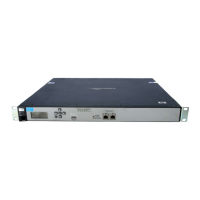Mobility traffic manager
Configuring Mobility Traffic Manager
9-11
About the default profiles
Two network profiles are created by default: LAN port network and Internet port
network. These profiles are associated with the two physical Ethernet ports on the
controller. You can rename these profiles, but you cannot assign a VLAN to them or delete
them. You can use these profiles to send untagged traffic to a specific port on the controller.
Both ports are considered to be local networks on the controller, which means that they
automatically map the network that is assigned to each physical port as a local network on
the controller. However, the LAN and Internet port network profiles can also be assigned as a
local network on an AP (for example, using the Controlled APs >> Configuration > Local
networks page). When this is done, both profiles refer to the untagged Ethernet port on the
AP.
Assigning a home network to a user
When you activate MTM support for a VSC, a user’s home network is defined in one of the
following ways:
It can be configured in the user’s account on a third-party RADIUS server by setting the
attributes Tunnel-Medium-Type, Tunnel-Private-Group-ID, and Tunnel-Type. For details
on how to set these attributes, see User attributes on page 15-13.
The Tunnel-Private-Group-ID attribute should be set to the name of the network profile
that identifies the user’s home network (A VLAN number can also be specified, but is not
recommended since two profiles could exist with the same VLAN ID but bound to
different physical ports or VLAN ports.)
Configured in a locally defined user account or user account profile. (User accounts are
defined by selecting Controller >> Users.) Currently this method only supports VLAN
ID. To specify a network profile name, Use the Custom attributes option in a network
profile to specify the attributes Tunnel-Medium-Type, Tunnel-Private-Group-ID, and
Tunnel-Type.
Configured by setting the Egress network option when binding the VSC to an AP group.
This lets you assign the same home network to a group of APs. Any user connected to one
of these APs then gets the specified home network. Note that if both the Egress network
and a RADIUS attribute are assigned, the Egress network is overwritten by the RADIUS
attribute.
A number of configuration settings on the controller can affect how user traffic is routed.
Some of these settings may override the choices you make to assign user traffic to a home
network. See Traffic flow for wireless users on page 7-6.
Note At least one controller must be assigned to each home network defined in the mobility
domain. See Local networks on page 9-8.

